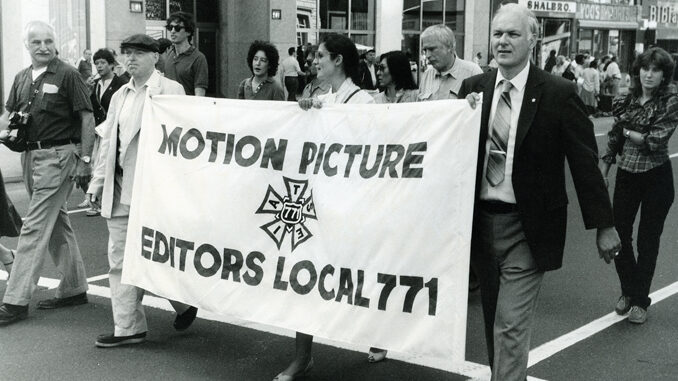
The 1980s were very busy years for the East Coast Editors Guild, Local 771, and the period of its highest level of membership. By 1987, more than 1,200 people were working in features and at the television networks.
They were also very busy years for William Bender, a successful Organizer with the Teamsters, who had worked as both an Organizer and Assistant Business Agent for Local 771. He was elected Business Agent in 1980, a position he held for 10 years. A tough negotiator who delivered many contracts, Bender finalized the Majors Contract, which was New York’s first formal agreement with the Association of Motion Picture and Television Producers (AMPTP).
He negotiated the “Collaborating Editor Clause” into the Major and Independent Agreements that year as well, which protected the union’s right to have a working, stand-by editor when an editor was brought in from another jurisdiction. In 1980, Bender additionally fought off a feature film strike, but the following year, he oversaw a year-long strike against Time-Life, the longest strike in the Local’s history.
Also in 1981, a Videotape Pilot program was discussed, as videotape had begun replacing film in the media. The Local purchased videotape equipment and began holding training classes at the Guild’s offices under the direction of Hal Bernard. A Videotape Agreement with the major feature film companies was reached, as was a Reciprocity Agreement with Local 776, the West Coast Editors Guild, which would ultimately lead to the merger of the Locals some 15 years later.
In addition, 1981 saw Local 771 taking a stand against polygraph testing of its members and opposing National Identity Cards.
By 1989, the work situation in New York began to change. The networks had eliminated almost all of their film jobs and switched everything to videotape. Since 771 did not hold those contracts, many members were put out of work and left the union. The crews in feature work also began to downsize, owing to technology changes. Many more members left 771, or moved to its West Coast counterpart, Local 776. The size of the membership shrank rapidly, and by 1990 was down to around 700 people.
Bender felt the effects of these difficulties and his relationship with the Board deteriorated, and he resigned from his post as Business Agent in 1990. \However, things began to turn around in the next decade. Not only did post-production employment begin to improve, and Guild membership increase, but Local 771’s office was modernized, both technologically and managerially. That period will be covered in the next issue of CineMontage.
Louis Bertini, MPSE





